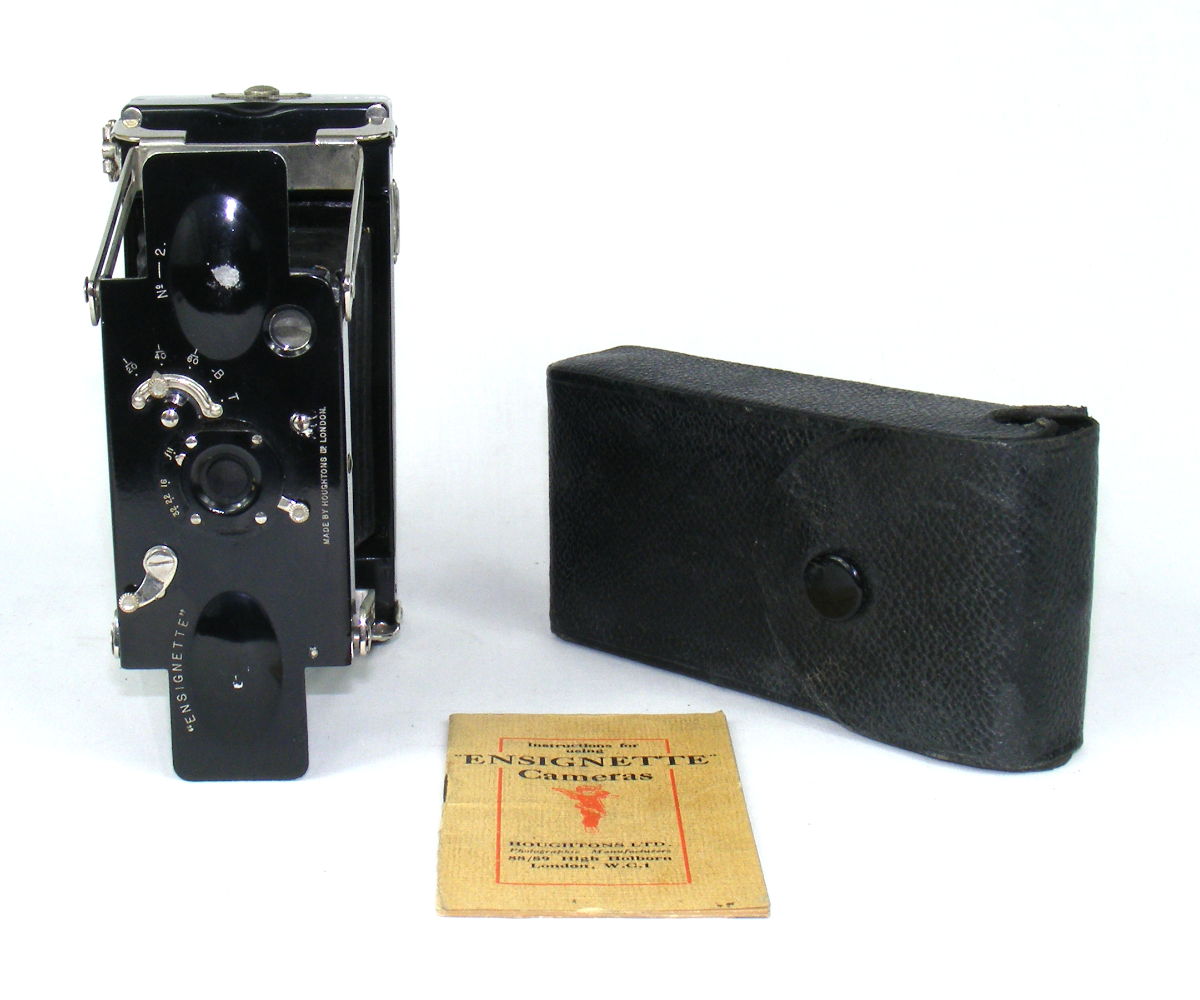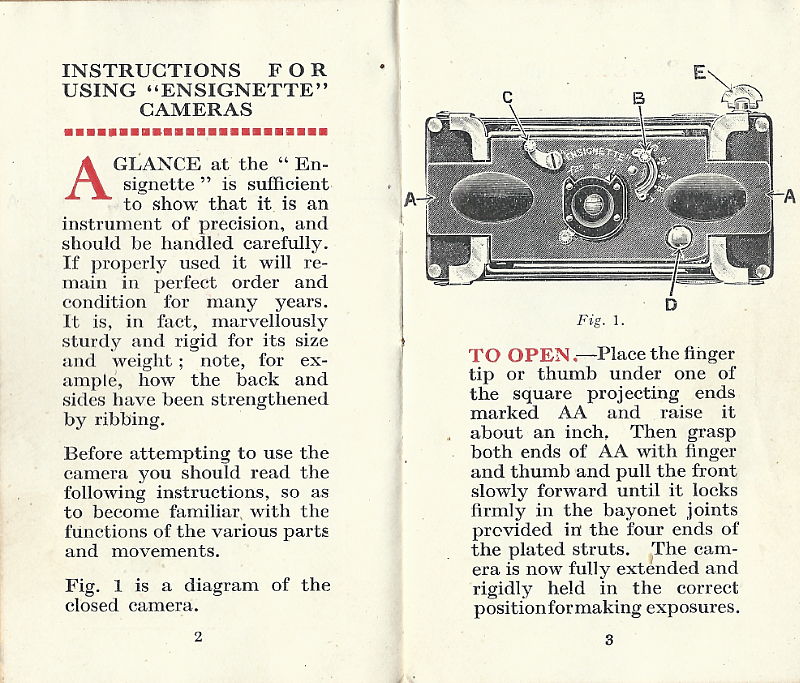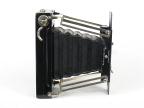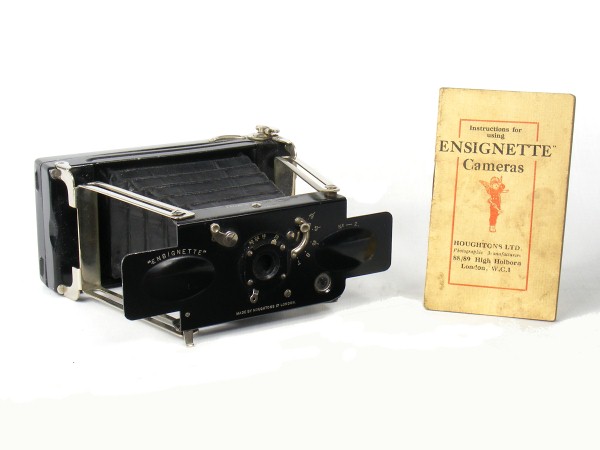Ensignette No 2
Houghtons Limited
| Name: | Ensignette No 2 |
| Manufacturer: | Houghtons Ltd. |
| Country of Origin: | United Kingdom |
| Plate / Film Size: | 2" x 3" rollfilm (e.g. Ensign E29) |
| Construction: | Bedless strut camera. The later pattern body was made in aluminium with nickel-plated fittings. |
| Movements: | None |
| Production Period: | 1912 - 1927 |
The Ensignette was designed by the Swedish Engineer Magnus Neill, who was also responsible for the design of the pocket watch camera called the 'Ticka' that was manufactured in Britain by Houghtons Ltd. Neill patented the design for the Ensignette in 1907; this date appears on the front of the camera. The camera was not introduced to the market at the end of 1909.
Early in 1912, presumably encouraged by the success of the Ensignette and the growing popularity of small pocket sized cameras, Houghtons introduced a new version. This new model was called the No.2 Ensignette, which took six pictures of a larger size of 3x2 inches on a new size of roll film 2E.
In about 1920 the design and manufacture was changed to use aluminium for the bodywork in place of brass.
According to Adrian Richmond's research (http://www.ensignphotographic.com/ensigncamerapage.htm, last accessed Feb 27, 2022), in 1927 the Ensignette disappeared altogether from catalogues of the newly formed Houghton-Butcher company. This decision must have been influenced by the fact that they had lost the battle with Kodak over film format. Houghton-Butcher conceding this by discontinuing the Ensignette in favour of the Vest Pocket Ensign (basically the same form as an Ensignette that used 127 film).
More history of the Ensignette cameras and its manufacturer Houghtons (later Houghton-Butcher) can be found on Adrian Richmond's excellent web site at http://www.ensignphotographic.com/ensigncamerapage.htm.
The picture below shows a no 1 Ensignette alongside the larger No 2 Ensignette for comparison.

| Lens: | Achromatic meniscus |
| Shutter: | 3 speed (1/20 - 1/60), B & T |
| Dimensions (w x h x l): | |
| Date of this Example: | c1925 |
| Serial Number: | Serial 2849 inside back around film window. |
| Availability: |
|
| Inventory Number: | 486 |
|
Photos copyright © 2015 David Purcell. Do not use without permission. |
Description
Aluminium body, with smooth enamel finish. Good condition overall, with minimal damage to front enamelled surface.
~ # ~ # ~
| Lens: | Achromatic meniscus |
| Shutter: | 3 speed (1/20 - 1/60), B & T |
| Movements: | None |
| Dimensions (w x h x l): | |
| Date of this Example: | c1920 |
| Serial Number: | Serial 446 inside back around film window. |
| Availability: |
|
| Inventory Number: | 199 |

Description
Aluminium body, with smooth enamel finish. Good condition overall, perhaps because it has been protected by its case, although the case might be responsible for the rubbing that has occurred on the front domes, one in particular. The camera also came with the Ensignette instruction booklet.
This example has a much earlier serial number than the previous example on this page, so is likely to date to much earlier in the period following the change to the aluminium body.
Notes
While the aluminium bodied cameras are often in better condition than the earlier brass models, it is often the case that the enamel shows wear on the domes. In many cases, this is quite likely to be due to the effect of the domes rubbing as the camera is taken in and out of the case. Finding one in pristine condition (and neither of the examples shown here can be described as such) is very difficult.
Watch out for fatigue in the aluminium too - this is most likely to be apparent in the two halves of the rear casing where oxide can build up making the camera very difficult to open.
The instructions shown in the photograph above cover both the No 1 and No 2 models, mentioning specifically the R.R. (Rapid Rectilinear) variants of both models. A picture within the booklet shows that it was produced for the aluminium version as it clearly shows the raised domes, as shown below. However, there is no date evident in the booklet itself.

For examples of other variants of the Ensignette No 2, refer to the page dedicated to the De Luxe models, and the page describing the Rapid Rectilinear model.
![[x]](../../images/checked.png)
![[ ]](../../images/unchecked.png)








